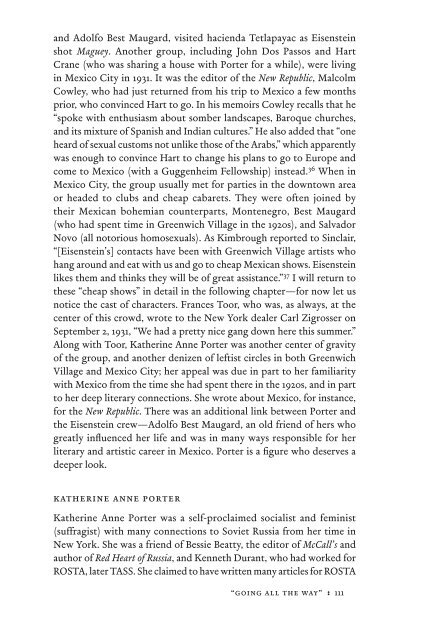In Excess: Sergei Eisentein's Mexico - Cineclub
In Excess: Sergei Eisentein's Mexico - Cineclub
In Excess: Sergei Eisentein's Mexico - Cineclub
Create successful ePaper yourself
Turn your PDF publications into a flip-book with our unique Google optimized e-Paper software.
and Adolfo Best Maugard, visited hacienda Tetlapayac as Eisenstein<br />
shot Maguey. Another group, including John Dos Passos and Hart<br />
Crane (who was sharing a house with Porter for a while), were living<br />
in <strong>Mexico</strong> City in 1931. It was the editor of the New Republic, Malcolm<br />
Cowley, who had just returned from his trip to <strong>Mexico</strong> a few months<br />
prior, who convinced Hart to go. <strong>In</strong> his memoirs Cowley recalls that he<br />
“spoke with enthusiasm about somber landscapes, Baroque churches,<br />
and its mixture of Spanish and <strong>In</strong>dian cultures.” He also added that “one<br />
heard of sexual customs not unlike those of the Arabs,” which apparently<br />
was enough to convince Hart to change his plans to go to Europe and<br />
come to <strong>Mexico</strong> (with a Guggenheim Fellowship) instead. 36 When in<br />
<strong>Mexico</strong> City, the group usually met for parties in the downtown area<br />
or headed to clubs and cheap cabarets. They were often joined by<br />
their Mexican bohemian counterparts, Montenegro, Best Maugard<br />
(who had spent time in Greenwich Village in the 1920s), and Salvador<br />
Novo (all notorious homosexuals). As Kimbrough reported to Sinclair,<br />
“[Eisenstein’s] contacts have been with Greenwich Village artists who<br />
hang around and eat with us and go to cheap Mexican shows. Eisenstein<br />
likes them and thinks they will be of great assistance.” 37 I will return to<br />
these “cheap shows” in detail in the following chapter—for now let us<br />
notice the cast of characters. Frances Toor, who was, as always, at the<br />
center of this crowd, wrote to the New York dealer Carl Zigrosser on<br />
September 2, 1931, “We had a pretty nice gang down here this summer.”<br />
Along with Toor, Katherine Anne Porter was another center of gravity<br />
of the group, and another denizen of leftist circles in both Greenwich<br />
Village and <strong>Mexico</strong> City; her appeal was due in part to her familiarity<br />
with <strong>Mexico</strong> from the time she had spent there in the 1920s, and in part<br />
to her deep literary connections. She wrote about <strong>Mexico</strong>, for instance,<br />
for the New Republic. There was an additional link between Porter and<br />
the Eisenstein crew—Adolfo Best Maugard, an old friend of hers who<br />
greatly infl uenced her life and was in many ways responsible for her<br />
literary and artistic career in <strong>Mexico</strong>. Porter is a fi gure who deserves a<br />
deeper look.<br />
katherine anne porter<br />
Katherine Anne Porter was a self-proclaimed socialist and feminist<br />
(suffragist) with many connections to Soviet Russia from her time in<br />
New York. She was a friend of Bessie Beatty, the editor of McCall’s and<br />
author of Red Heart of Russia, and Kenneth Durant, who had worked for<br />
ROSTA, later TASS. She claimed to have written many articles for ROSTA<br />
“going all the way” : 111


